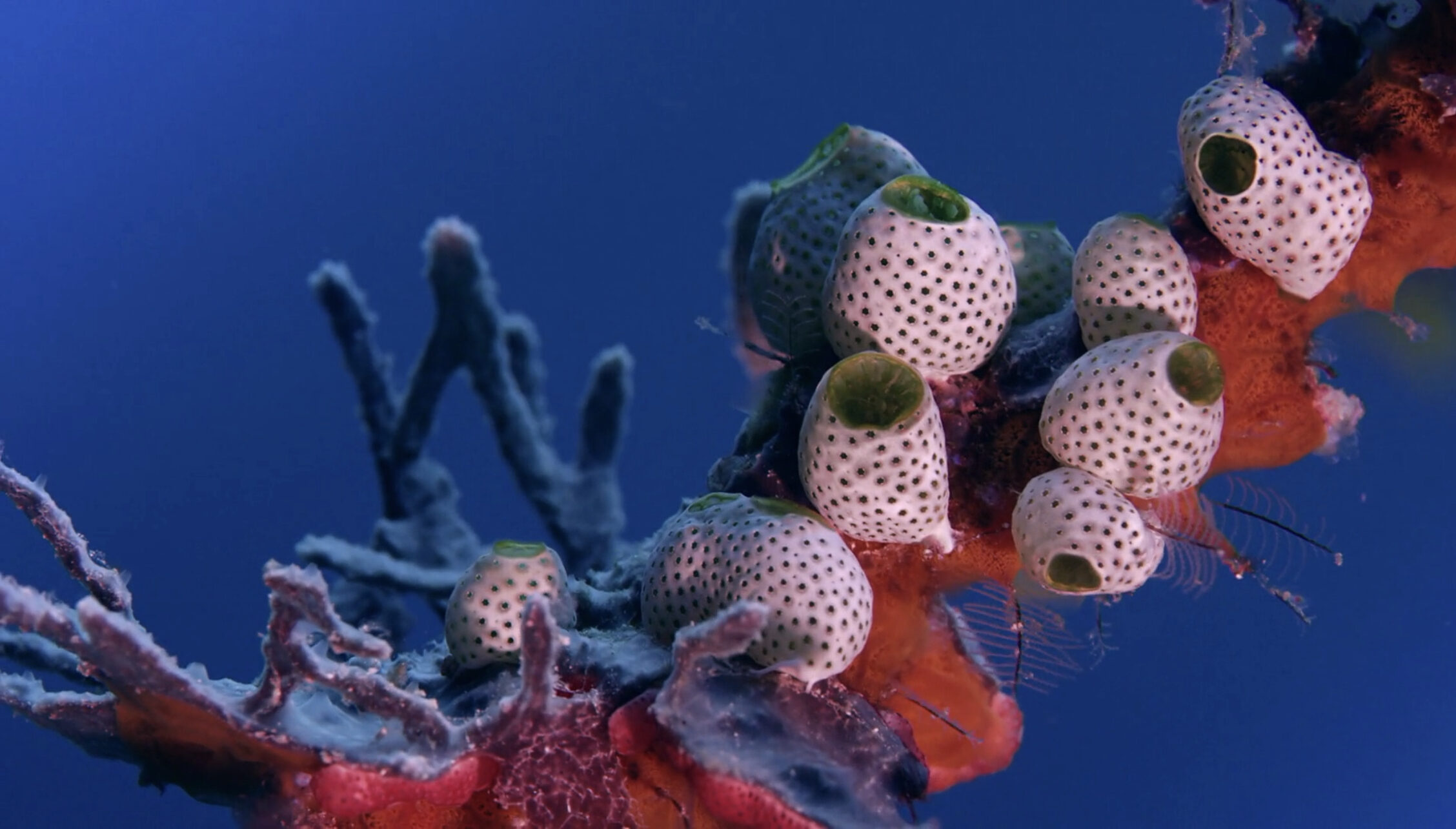Sea squirts are filter feeders that help keep ecosystems healthy by filtering out harmful waste from the ocean, like microplastics and heavy metals. They will attach themselves to solid objects like sponges, rocks, and seashells. These green sea squirts are attached to a red sponge. They range from palm-sized to as large as 3ft/ 1m. Sea squirts are also known for having medicinal properties used in the treatment of certain forms of cancer, can create colonies by reproducing asexually, and have cells made from cellulose—a compound that was once thought to exist only in plants. There are genetically 80% similar to humans.
An invertebrate is an animal that doesn’t have a spine. Other examples of invertebrates include jellyfish, horseshoe crabs, snails, spiders, and squid. Sea squirts are born with a notochord, a structure that provides signals during development that later disappears.
Most adult sea squirts are immobile but some have been recorded moving up to 0.6 inch/ 1.5 cm per day.
Sea squirt research is vital because sea squirts are genetically 80% similar to humans. Sea squirts and humans are a part of a group of animals called chordates—having some spinal cord development. Some scientists believe that sea squirts are potentially what the very first human ancestor, with a primitive spinal cord, may have been like 550 million years ago.

Where Do Sea Squirts Live
Sea squirts are found in all seas, ranging from the shore to deep in the ocean. They will attach themselves to solid objects like sponges, rocks, seashells, and crabs. They will also attach to manmade structures like the hulls of ships and piers.
What Do Sea Squirts Eat
A sea squirt’s body is often described as feeling like rubber or leather. The main structure is called the tunic. They have two openings that face up, one for water to enter carrying nutrients and oxygen and one for waste to exit.
Sea squirts eat a diet of plankton and debris from dead plants and animals.
Medicinal Properties of Sea Squirts
Sea squirts have medicinal properties, such as a compound called didemnins that are used in the treatment of different forms of cancer. Once it was discovered how to create a synthetic version of trabectedin, a didemnin, it was patented, licensed, mass produced, and made available to patients to treat soft-tissue carcinoma and ovarian cancer.
Scientists are studying sea squirts to have the ability to regenerate cells to determine the potential ability of cells and tissues to regenerate tissue in damaged human organs. Studies are also being conducted on sea squirt compounds in the use as an antiviral for COVID-19.
Sources
“Yondelis”. Therapeutic Goods Administration (TGA). 3 May 2021. Retrieved 4 January 2023.
Avisar, D. , Kaplan, A. , Ronen-Eliraz, G. , Vered, G. , Shenkar, N. and Gozlan, I. (2019) Validated Method for the Detection of Three Phthalates Derived from Marine Invertebrates. American Journal of Analytical Chemistry, 10, 445-458. doi: 10.4236/ajac.2019.1010032.
Kürn, Ulrich; Rendulic, Snjezana; Tiozzo, Stefano; Lauzon, Robert J. (August 2011). “Asexual Propagation and Regeneration in Colonial Ascidians”. The Biological Bulletin. 221 (1): 43–61. doi:10.1086/BBLv221n1p43. ISSN 0006-3185. PMID 21876110. S2CID 37526690.
Matthysse, A.G.; Deschet, K.; Williams, M.; Marry, M.; White, A.R. & Smith, W.C. (2004). “A functional cellulose synthase from ascidian epidermis”. Proceedings of the National Academy of Sciences. 101 (4): 986–991. Bibcode:2004PNAS..101..986M. doi:10.1073/pnas.0303623101. PMC 327129. PMID 14722352
Sasakura, Y.; Nakashima, K.; Awazu, S.; Matsuoka, T.; Nakayama, A.; Azuma, J. & Satoh, N. (2005). “Transposon-mediated insertional mutagenesis revealed the functions of animal cellulose synthase in the ascidian Ciona intestinalis”. Proceedings of the National Academy of Sciences. 102 (42): 15134–15139. Bibcode:2005PNAS..10215134S. doi:10.1073/pnas.0503640102. PMC 1257696. PMID 16214891
Sasakura, Y.; Ogura, Y.; Treen, N.; et al. (2016). “Transcriptional regulation of a horizontally transferred gene from bacterium to chordate”. Proceedings of the Royal Society B. 283 (1845): 20161712. doi:10.1098/rspb.2016.1712. PMC 5204163. PMID 28003446.
“Sea Squirt, Heal Thyself: Scientists Make Major Breakthrough in Regenerative Medicine”. Sciencedaily.com. Published 25 April 2007.







